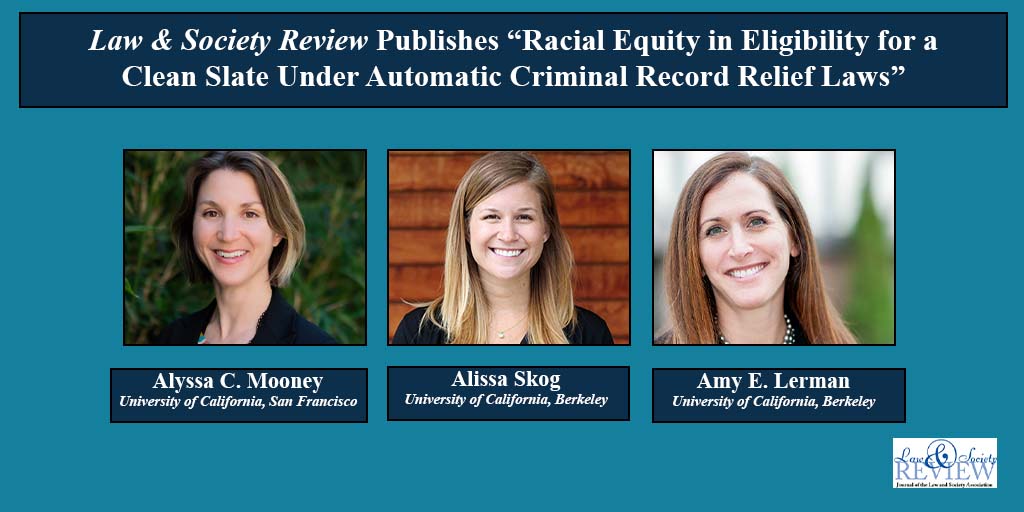The authors find that the share of Black Americans eligible for automatic relief is lower than white Americans, reproducing racial disparities in criminal records

AMHERST, Mass. – Although they are well-intentioned, eligibility criteria for recent automatic criminal record relief laws used around the country can inadvertently perpetuate racial inequity within the criminal justice system.
The latest issue of the Law & Society Review features innovative research on criminal record relief reform through the publication of “Racial Equity in Eligibility for a Clean Slate Under Automatic Criminal Record Relief Laws” by California-based scholars Alyssa C. Mooney (University of California, San Francisco), Alissa Skog (University of California, Berkeley) and Amy E. Lerman (University of California, Berkeley). Their article sheds light on racial inequities in eligibility among current relief laws in California and identifies two policy amendments that would reduce the share of Black men in California with a conviction record from 22% to 9%. There is currently a 15 percentage point difference between the share of Black men in California who have a conviction record versus white men, and these policy changes would narrow the gap to seven percentage points.
“One of the explicit aims of record clearance policies is to undo the lasting stigma of a criminal record, which has been disproportionately harmful to Black Americans,” said Professor Lerman. “In our study, we analyze how different record clearance policies would interact with patterns in criminal records that map on to race, to try to predict in advance whether efforts to remove criminal records could create unintended consequences that actually increase racial inequity.”
States have recently started enacting automatic criminal record relief laws. These laws allow authorities to regularly review data systems to provide relief for eligible individuals with arrests that never led to convictions. This includes most misdemeanors and low-level felony convictions. They are designed to take the burden of the court petition process off the shoulders of the person with a record.
However, Mooney, Skog and Lerman show how these relief laws can unintentionally maintain racial disparities in criminal records. The authors then suggest ways in which relief laws could instead maximize their potential to reverse these harms. They argue that automating the record clearing process alone is not enough and that in order to reduce the racial gap in criminal records, a change in policy needs to happen to extend record clearance eligibility to a wider range of cases—for example, people with felonies or those sent to prison who are currently excluded.
The study could inform future policy efforts, potentially helping policymakers to avoid the unintended consequences that can result from even well-intentioned efforts at reform. “One of the most important aspects of our study is it provides an example of how we can use data to try to predict the consequences of policies for racial equity before we pass those policies and experience their potentially unintended negative consequences or how they inadvertently do harm,” said Lerman.
To assess equity in eligibility for criminal record relief, the authors use criminal history data from the California Department of Justice, consisting of 2,246,101 people who were arrested in the years 2000-2016. The authors first assess the share of people who are eligible to clear every conviction on their record under current laws and then examine how this varies across racial and ethnic groups. Next, they evaluate how specific recommended changes to the current eligibility requirements and the implementation of adjusted criminal record relief laws could address these racial inequalities.
The authors find that one in five people with convictions in California met criteria for full conviction relief under the state’s automatic relief laws. However, the share of Black Americans eligible for relief was lower than white Americans, reproducing racial disparities in criminal records.
This disparity (or difference) resulted from a higher likelihood of felony convictions, and among those, a higher likelihood of cases that were not eligible under current laws, even if the sentence was complete. Hinging eligibility on criminal records produced by historical racial discrimination in policing and prosecution—such as the prison sentence exclusion—confers disproportionate benefits of automatic relief to white people and must be examined and justified as an exclusionary criterion.
The article includes a discussion of how its findings can reveal the persistent role of race in criminal justice reform, even in cases where the explicit intent is to reduce the harms of mass incarceration. The adjusted reform measures proposed by the authors aim to widen the criteria for automatic relief. Through these recommendations, relief eligibility would factor in discretionary convictions and include a “seven-year sunset rule,” which would provide relief for any conviction seven years after the sentence is complete.
“Black-white and Latino-white disparities would be cut approximately in half, but would persist at 4.0 and 0.5 percentage points, respectively, among all adults, and 6.8 and 1.1 among men,” explained the authors. “The persistent disparities in records of a criminal conviction when both hypothetical reforms were incorporated suggest that Black people are more likely to have charges pending and/or incomplete sentences on a conviction.”
The discussion also flags the severity of missing data across counties, and the dangers that criminal records may persist in online databases. Each of these phenomena may affect a significant proportion of those with criminal records, further amplifying racial inequalities when it comes to getting a clean slate.
“Under the new law, eligible cases will be granted automatic relief in the state’s database, yet our findings highlight that missing case information from counties is a huge challenge for determining eligibility,” Mooney explained. “There is a need for more work on how administrative data quality affects equitable policy change, and whether county resources for data systems determine local effects of state reforms.”
“One perennial challenge is notifying individuals that their records are cleared,” added Skog. “It is incredibly onerous—and often not possible—to locate current contact information for all individuals who will benefit from relief. Plus, there are critical privacy concerns surrounding notification.”
Volume 56, Issue 3 is available online here. It includes seven articles and two book reviews. To read this full LSR article, visit the Wiley Online Library here.
###


